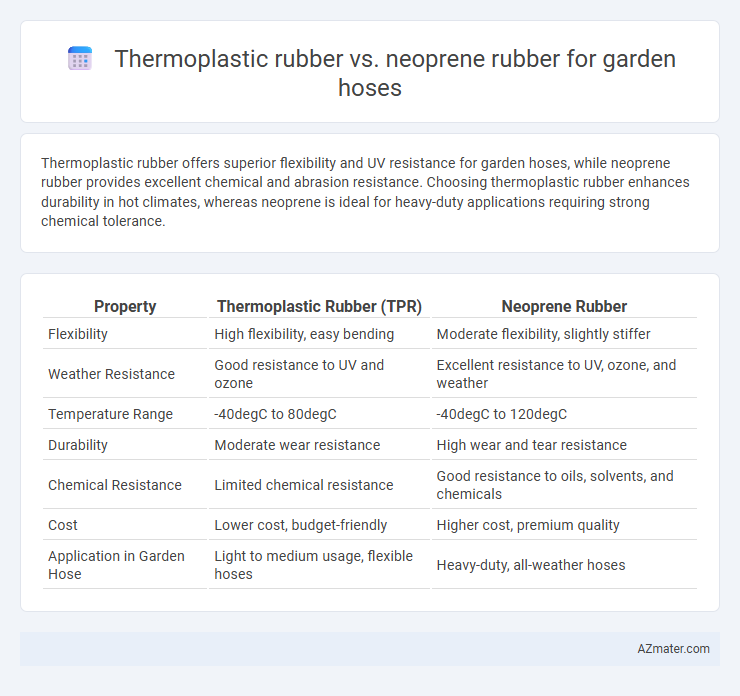Thermoplastic rubber offers superior flexibility and UV resistance for garden hoses, while neoprene rubber provides excellent chemical and abrasion resistance. Choosing thermoplastic rubber enhances durability in hot climates, whereas neoprene is ideal for heavy-duty applications requiring strong chemical tolerance.
Table of Comparison
| Property | Thermoplastic Rubber (TPR) | Neoprene Rubber |
|---|---|---|
| Flexibility | High flexibility, easy bending | Moderate flexibility, slightly stiffer |
| Weather Resistance | Good resistance to UV and ozone | Excellent resistance to UV, ozone, and weather |
| Temperature Range | -40degC to 80degC | -40degC to 120degC |
| Durability | Moderate wear resistance | High wear and tear resistance |
| Chemical Resistance | Limited chemical resistance | Good resistance to oils, solvents, and chemicals |
| Cost | Lower cost, budget-friendly | Higher cost, premium quality |
| Application in Garden Hose | Light to medium usage, flexible hoses | Heavy-duty, all-weather hoses |
Introduction to Garden Hose Materials
Garden hoses typically utilize materials like thermoplastic rubber and neoprene rubber, each offering distinct advantages for durability and flexibility. Thermoplastic rubber combines the elasticity of rubber with the processability of plastics, providing lightweight, kink-resistant properties ideal for general gardening tasks. Neoprene rubber, known for its superior resistance to weathering, ozone, and temperature extremes, ensures longer-lasting performance in harsh outdoor environments, making it suitable for more demanding garden hose applications.
What is Thermoplastic Rubber?
Thermoplastic rubber (TPR) is a versatile elastomer combining the elasticity of rubber with the processability of plastics, making it ideal for garden hoses due to its flexibility and durability. Unlike neoprene rubber, TPR can be melted and reshaped multiple times, allowing for efficient manufacturing and recycling. Its resistance to weathering, abrasion, and chemicals ensures long-lasting performance in various outdoor conditions.
What is Neoprene Rubber?
Neoprene rubber is a synthetic elastomer known for its excellent resistance to weathering, ozone, and various chemicals, making it a durable choice for garden hoses exposed to outdoor conditions. It maintains flexibility across a wide temperature range and offers superior abrasion resistance compared to thermoplastic rubber, ensuring long-lasting performance during regular use. Neoprene's unique chemical composition also provides enhanced elasticity and strength, which helps prevent cracking and wear in garden hose applications.
Durability: Thermoplastic vs Neoprene
Thermoplastic rubber garden hoses offer excellent resistance to cracking, UV rays, and weather aging, ensuring long-lasting durability in various outdoor conditions. Neoprene rubber hoses provide superior chemical resistance and maintain flexibility at low temperatures, making them durable for harsh environments and extended use. When comparing overall durability, thermoplastic rubber excels in abrasion and weather resistance, while neoprene rubber is preferred for toughness against oils and cold climates.
Flexibility and Handling in the Garden
Thermoplastic rubber offers superior flexibility and lightweight handling, making garden hoses easier to maneuver around plants and obstacles. Neoprene rubber provides excellent durability but tends to be stiffer, which can reduce ease of use during prolonged gardening tasks. Choosing thermoplastic rubber enhances user comfort by allowing smoother bending and less kinking under varied outdoor conditions.
Weather Resistance Comparison
Thermoplastic rubber (TPR) offers moderate weather resistance with good flexibility in varying temperatures but may degrade faster under prolonged UV exposure and extreme cold. Neoprene rubber excels in weather resistance, maintaining elasticity and durability against UV rays, ozone, and harsh weather conditions, making it ideal for garden hoses exposed to outdoor elements. For long-term use in fluctuating climates, neoprene garden hoses provide superior protection and longevity compared to TPR alternatives.
Chemical and UV Resistance
Thermoplastic rubber offers moderate chemical resistance but generally lacks strong UV stability, making it less ideal for prolonged outdoor use in garden hoses. Neoprene rubber exhibits superior resistance to oils, acids, and ozone, coupled with excellent UV resistance, which enhances its durability in harsh environmental conditions. For garden hoses exposed to sunlight and various chemicals, neoprene provides better long-term performance and reliability.
Weight and Portability Differences
Thermoplastic rubber garden hoses are typically lighter and more flexible than neoprene rubber hoses, enhancing portability and ease of handling during extended use. Neoprene rubber, while heavier, offers greater durability and resistance to abrasion, making it suitable for demanding gardening tasks but less convenient for frequent transport. The weight difference directly impacts user fatigue and storage options, with thermoplastic rubber being advantageous for lightweight, portable garden hoses.
Cost and Value Analysis
Thermoplastic rubber (TPR) offers a lower initial cost and greater flexibility compared to neoprene rubber, making it a budget-friendly option for garden hoses with adequate durability for light to moderate use. Neoprene rubber, although more expensive, provides superior resistance to UV rays, ozone, and weathering, ensuring long-term value and less frequent replacement in harsh outdoor conditions. Evaluating total cost of ownership, neoprene hoses deliver better longevity and performance, justifying their higher upfront investment for heavy-duty gardening applications.
Which Rubber is Best for Your Garden Hose?
Thermoplastic rubber (TPR) offers excellent flexibility, durability, and resistance to UV rays and ozone, making it ideal for lightweight, kink-resistant garden hoses. Neoprene rubber excels in temperature resistance, chemical stability, and abrasion resistance, suitable for heavy-duty garden hoses used in harsh environments. For most residential garden hoses, thermoplastic rubber balances cost and performance, while neoprene is better for industrial or extreme weather applications.

Infographic: Thermoplastic rubber vs Neoprene rubber for Garden hose
 azmater.com
azmater.com